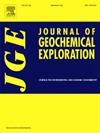Mercury in the natural environment: Biogeochemical cycles and associated health risks
IF 3.4
2区 地球科学
Q1 GEOCHEMISTRY & GEOPHYSICS
引用次数: 0
Abstract
Mercury (Hg) is an integral part of Earth's biogeochemical cycles, yet anthropogenic activities significantly elevate its environmental presence, posing considerable ecological and human health risks. Human exposure primarily arises from the consumption of Hg-contaminated freshwater and marine fish. The Minamata Convention on Mercury, initiated by the United Nations Environment Programme (UNEP), aims to mitigate global Hg emissions, reinforced by comprehensive monitoring efforts. The biogeochemical cycling of Hg is complex, encompassing intricate processes of distribution, transformation, and bioaccumulation that connect sources to exposure pathways. Thus, evaluating Hg biogeochemical behavior and potential environmental hazards is crucial in the global scientific fraternity. Although global policies address direct Hg emissions, comprehending its biogeochemical cycling remains challenging and continues to spur scientific investigation. Coal combustion is a significant source, accounting for approximately 60 % of Hg emissions, especially in geologically predisposed regions, with atmospheric deposition being a key factor, leading to elevated Hg levels in terrestrial soils. Health risks associated with Hg exposure are more acute in soil-contaminated environments than in aquatic systems, with ingestion posing greater risks than dermal contact. This review focuses on the biogeochemical cycling of Hg in the natural environment, highlighting contamination patterns and providing updated insights into Hg's impact on aquatic and terrestrial ecosystems.
自然环境中的汞:生物地球化学循环和相关的健康风险
汞(Hg)是地球生物地球化学循环中不可或缺的一部分,但人类活动大大提高了汞在环境中的存在,对生态和人类健康造成了相当大的风险。人类接触汞的主要途径是食用受汞污染的淡水鱼和海鱼。联合国环境规划署(UNEP)发起的《关于汞的水俣公约》旨在通过全面监测工作,减少全球汞排放。汞的生物地球化学循环非常复杂,包括分布、转化和生物累积等错综复杂的过程,这些过程将汞的来源与接触途径联系在一起。因此,评估汞的生物地球化学行为和潜在环境危害对全球科学界至关重要。尽管全球政策都在解决汞的直接排放问题,但了解汞的生物地球化学循环仍具有挑战性,并将继续推动科学研究。燃煤是一个重要的汞排放源,约占汞排放总量的 60%,特别是在地质条件较差的地区,大气沉降是导致陆地土壤中汞含量升高的一个关键因素。与水生系统相比,在土壤污染环境中接触汞对健康造成的风险更大,摄入汞比皮肤接触汞造成的风险更大。本综述重点介绍汞在自然环境中的生物地球化学循环,突出污染模式,并就汞对水生和陆生生态系统的影响提供最新见解。
本文章由计算机程序翻译,如有差异,请以英文原文为准。
求助全文
约1分钟内获得全文
求助全文
来源期刊

Journal of Geochemical Exploration
地学-地球化学与地球物理
CiteScore
7.40
自引率
7.70%
发文量
148
审稿时长
8.1 months
期刊介绍:
Journal of Geochemical Exploration is mostly dedicated to publication of original studies in exploration and environmental geochemistry and related topics.
Contributions considered of prevalent interest for the journal include researches based on the application of innovative methods to:
define the genesis and the evolution of mineral deposits including transfer of elements in large-scale mineralized areas.
analyze complex systems at the boundaries between bio-geochemistry, metal transport and mineral accumulation.
evaluate effects of historical mining activities on the surface environment.
trace pollutant sources and define their fate and transport models in the near-surface and surface environments involving solid, fluid and aerial matrices.
assess and quantify natural and technogenic radioactivity in the environment.
determine geochemical anomalies and set baseline reference values using compositional data analysis, multivariate statistics and geo-spatial analysis.
assess the impacts of anthropogenic contamination on ecosystems and human health at local and regional scale to prioritize and classify risks through deterministic and stochastic approaches.
Papers dedicated to the presentation of newly developed methods in analytical geochemistry to be applied in the field or in laboratory are also within the topics of interest for the journal.
 求助内容:
求助内容: 应助结果提醒方式:
应助结果提醒方式:


